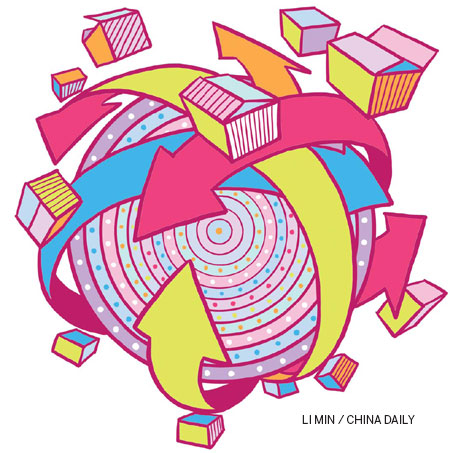Trade winds to blow hot and cold
Updated: 2013-01-07 10:05
By Li Jian (China Daily)
|
||||||||

China Sails into 2013 with exports and imports set to grow steadily
In 2012, with the eurozone crisis and shrinking global demand, China's foreign trade growth slowed to about 6 percent - but this was still higher than the world as a whole and that of some major economies.
The picture for 2013 looks similar, with the outlook for the global economy remaining gloomy, while China's foreign trade is set to grow slightly higher than in 2012.
Since the second quarter of last year, the recovery of the US economy has slowed, the eurozone debt crisis deepened and Japan stepped into economic recession. The growth of emerging and developing economies also slowed.
According to the latest International Monetary Fund report, the global economy will grow 3.6 percent in 2013, only 0.3 percentage points higher than in 2012. Demand from developed economies will grow by 1.3 percent, 0.2 percentage points higher than last year. It also predicted that the emerging economies will grow faster than developed ones, but the growth rate will still be dropping. All this indicates that sluggish external demand will not change in 2013.
In China, a series of policies were enacted in time to stimulate internal demand. In the second half of last year, China regained its economic growth rate gradually. This year, internal demands for daily commodities will grow mildly due to rising incomes and living standards. Also, with the increased pace of industrialization and urbanization, demand for energy resources will grow.
In November, the new generation of leaders signaled greater economic reform and opening-up. The Ministry of Finance released new import tariffs for 2013 on 784 imported products as part of a major effort to boost domestic consumption. The temporary adjustment will allow the products to be imported on a tax rate lower than the most-favored-nation tariff.
The move is expected to increase imports, facilitating the global trade balance and creating a better external economic environment for China.
From an international standpoint, whether the eurozone can prevent its debt crisis deepening is the most important issue. The next is whether the US can continue its economic recovery. Washington will inevitably take measures in 2013 that will impose negative effects on its economy.
The other important factor is whether emerging economies can survive the global financial and commodities market. Key economies including the US, the EU and Japan are all employing quantitative-easing policies, and some countries, such as Australia, have lowered interest rates to stimulate economic development.
In 2013, fluctuation in exchange rates and turbulence in global financial market are inevitable. The pricing trends of bulk consumer goods are unclear, which will hit emerging economies that rely on the export or import of energy resources.
In China, the problems in balancing its economy still exist. It is also losing its demographic dividend, leading to shrinking profits for enterprises, and environmental issues are hampering economic development.
The advantage China used to have in being able to stimulate its economy is fading, and a new strategy for competitiveness has not been formed yet. Economic growth will continue to slow down gradually.
China's growth is predicted at 8 percent this year, with annual trade volume of around $4.2 trillion (3.2 trillion euros).

 Li Na on Time cover, makes influential 100 list
Li Na on Time cover, makes influential 100 list
 FBI releases photos of 2 Boston bombings suspects
FBI releases photos of 2 Boston bombings suspects
 World's wackiest hairstyles
World's wackiest hairstyles
 Sandstorms strike Northwest China
Sandstorms strike Northwest China
 Never-seen photos of Madonna on display
Never-seen photos of Madonna on display
 H7N9 outbreak linked to waterfowl migration
H7N9 outbreak linked to waterfowl migration
 Dozens feared dead in Texas plant blast
Dozens feared dead in Texas plant blast
 Venezuelan court rules out manual votes counting
Venezuelan court rules out manual votes counting
Most Viewed
Editor's Picks

|

|

|

|

|

|
Today's Top News
Boston bombing suspect reported cornered on boat
7.0-magnitude quake hits Sichuan
Cross-talk artist helps to spread the word
'Green' awareness levels drop in Beijing
Palace Museum spruces up
First couple on Time's list of most influential
H7N9 flu transmission studied
Trading channels 'need to broaden'
US Weekly

|

|







